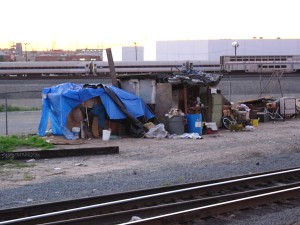
Irina Nersessova’s “Tapestry Of Space: Domestic Architecture And Underground Communities In Margaret Morton’s Photography Of A Forgotten New York” analyzes Margaret Morton’s photographs and perception of the homeless in New York and makes a connection between urban space and one’s behavior. This article emphasizes the true meaning of being homeless, what can come of it, and what can drive you to it. It shows the real reasons behind being homeless and the reality of living as a homeless person.
Having a home, no matter what type of home it is, is necessary to humans because shelter is a necessity in one’s life. Not having a stable home is the true idea behind being homeless, because they have a home even though it is not consistent. Not owning a home does not make a person homeless, because many people who have a place to live do not own a home. Instead, it is the fragility and susceptibility of a home that makes the person living there homeless. Nersessova points out the relationship between human identity and space when commenting on how the homeless put their items together in an organized manner to try to form a sense of identity. The way the homeless work to survive in their way of living helps them gain more self understanding. One man that Morton interviewed was able to focus more on himself with being away from all of the worldly things of the city. Life in the tunnel is portrayed as a place a person can find themselves rather than solely as a symbol of poverty. Another man that was interviewed used the tunnel as his safe place because the average person was afraid to enter because of how dark the tunnel is. Nersessova highlights the fact that Morton clarifies that life in the tunnel is not ideal by letting an interviewee explain how it can take over a person’s life. The people who live in the tunnel gain a specific bond with the city; because of the knowledge they had of the city before living in the tunnel, they already know how to get supplies such as food. For many residents of the tunnel, it has become their home because it is too chaotic above ground in the city. Not only is the tunnel a place to live, but it also provides opportunity for creativity for the people who live there. Not all of the people who lived in the tunnel that were interviewed by Morton stayed in the tunnel. Some of the people who once lived in the tunnel left to try again above ground. The tunnel is not glamorous by all means, but it seems to provide opportunities, such as finding yourself, that may not be easily found somewhere else.
There is also a relationship between space and social justice. The architecture of the city can prevent certain classes of people from being included, and it can segregate different types of people. Psychogeography in the city has created social classes and the division between those people in each class. It is created from urban space’s influence on the people’s behavior. Capitalism in the city has forced the homeless out of sight in order to attract more consumers. Even with being pushed out of sight, the homeless still manage to find a way to live in the system that has failed them.
The main arguments made by Nersessova in this analysis that i picked up on are that homeless people are very similar to people who have stable homes, and that the tunnel is not all bad, good does come from it. Homeless people have the same needs, everybody needs to get away to find themselves sometimes. People just have different ways of going about this.